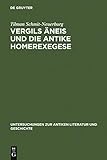Vergils Äneis und die antike Homerexegese : Untersuchungen zum Einfluß ethischer und kritischer Homerrezeption auf imitatio und aemulatio Vergils / Tilman Schmit-Neuerburg.
Material type: TextSeries: Untersuchungen zur antiken Literatur und Geschichte ; 56Publisher: Berlin ; Boston : De Gruyter, [2011]Copyright date: ©1999Edition: Reprint 2011Description: 1 online resource (381 p.)Content type:
TextSeries: Untersuchungen zur antiken Literatur und Geschichte ; 56Publisher: Berlin ; Boston : De Gruyter, [2011]Copyright date: ©1999Edition: Reprint 2011Description: 1 online resource (381 p.)Content type: - 9783110165586
- 9783110807615
- 808.81 22
- PA6825 .S445 1999eb
- online - DeGruyter
- Issued also in print.
| Item type | Current library | Call number | URL | Status | Notes | Barcode | |
|---|---|---|---|---|---|---|---|
 eBook
eBook
|
Biblioteca "Angelicum" Pont. Univ. S.Tommaso d'Aquino Nuvola online | online - DeGruyter (Browse shelf(Opens below)) | Online access | Not for loan (Accesso limitato) | Accesso per gli utenti autorizzati / Access for authorized users | (dgr)9783110807615 |
Frontmatter -- Vorwort -- Inhaltsverzeichnis -- I. Einleitung -- II. Ethische Exegese -- III. Gleichnisse und Metaphorik -- IV. Kritische Exegese -- V. Worterklärung und Realienkommentierung -- VI. Schlußbemerkung -- VII. Anhang: Auf dem Weg zu einem ‘neuen Vergil’ -- VIII. Literaturverzeichnis -- IX. Indices -- Backmatter
restricted access online access with authorization star
http://purl.org/coar/access_right/c_16ec
A deeper understanding of Virgil’s Aeneid can only be achieved through the Iliad and Odyssey as its most important models. As the author shows, Classical views of Homer differ significantly from those prevailing today, and this allows the conception of the Aeneid to be seen in a new light. In the first part of the study, the author analyses the way in which Virgil indirectly characterises the protagonists of his epic (incl. Aeneas, Turnus, Dido) through allusions to the contemporary philosophical and ethical understanding of Homer’s models. In the second part, the author examines how the “poeta doctusR02;” creatively transforms the Hellenistic critique of Homer in the Aeneid.
Ein tieferes Verständnis von Vergils Aeneis erschließt sich nur auf dem Hintergrund von Ilias und Odyssee als ihren wichtigsten Vorbildern. Wie der Autor zeigt, unterscheidet sich das antike Homerbild wesentlich von dem heutigen, womit auch die Konzeption der Aeneis in neuem Licht erscheint: Im ersten Teil der Untersuchung wird analysiert, wie Vergil namentlich die Protagonisten seines Epos (Aeneas, Turnus, Dido u.a.) durch Anspielungen auf das zeitgenössische philosophisch-ethische Verständnis der homerischen Vorbildgestalten indirekt charakterisiert. Im zweiten Teil untersucht der Autor, wie der "poeta doctus" die hellenistische Homerkritik in der Aeneis schöpferisch umsetzt.
Issued also in print.
Mode of access: Internet via World Wide Web.
In German.
Description based on online resource; title from PDF title page (publisher's Web site, viewed 28. Feb 2023)


